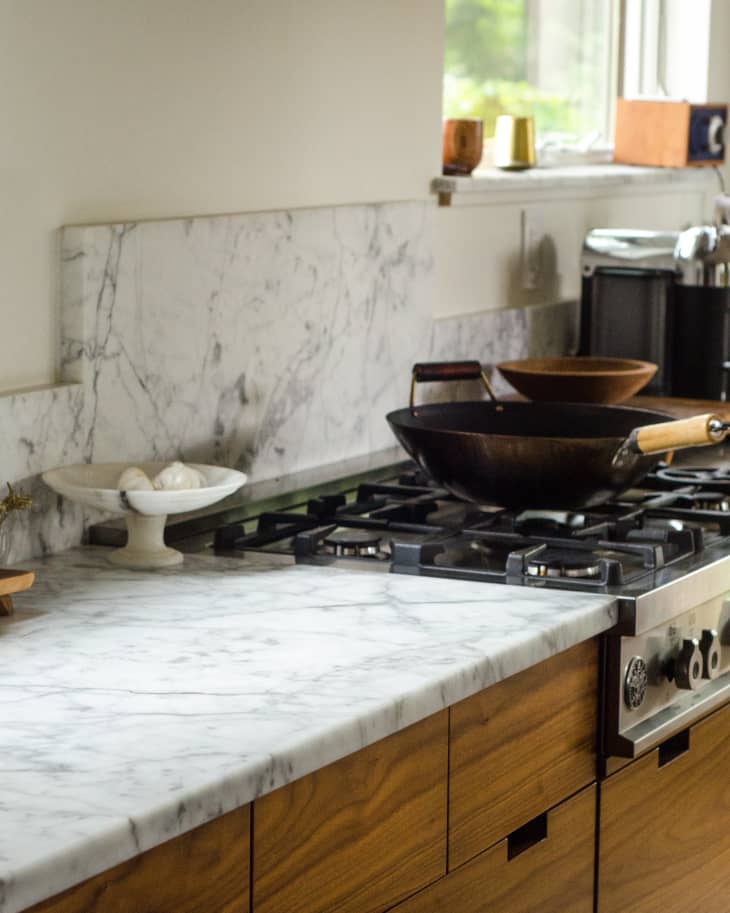Here’s What an Etch on a Marble Countertop Actually Looks Like
When my husband and I were researching our kitchen renovation a couple years ago, marble countertops were the clear frontrunner, but we were nervous about the inevitable etching. So we paid visits to every marble-topped bar and marble-furnished ice cream parlor we could find, cocking our heads to the side, peering down long polished surfaces to examine the damage left by countless drippy glasses and plates of spaghetti.
We ended up with marble and we’re very happy with it. But if you’re also in that decision-making process, let me help you out and save you a few trips. Here’s what marble etches look like up close and personal in my own kitchen.
First, What’s an Etch?
Marble is a fairly soft stone and it is prone to marking because of its calcium carbonate makeup. Acid reacts with calcium carbonate and literally eats away a tiny bit of the surface, creating dull spots known as etches. Any splash of lemon juice, any drippy jar of tomato sauce, is going to leave a subtle mark.
An etch is not a stain. It is an actual changing of the stone itself, like a scratch. It’s not really a discoloration; it’s a dulling.
Honed vs. Polished Countertops
Etching is part of the reason I chose honed instead of polished countertops. Honed countertops have already been dulled either by a machine or an acid bath. They are matte and soft, compared to shiny polished stone. This duller, more matte stone is more casual and easy to live with in my opinion, since it naturally shows etches (dull spots) less than dressier polished marble.
More about my marble installation: Faith’s Kitchen Renovation: How We Finally Got Our Carrara Marble Countertops
My Countertop: From Two Different Angles
Here’s what you came to see: the etched countertop. I’ll show it to you from two different angles, since etches are actually quite hard to see from most angles and in most lights.
This is the most-used part of my kitchen: the prep space where I chop vegetables, make sauces, and use my food processor. I squeeze lemons for cocktails here, and pour wine. It’s Etch City.
Here’s the countertop as you see it when just entering the kitchen:
No Etches Visible
There’s no major retouching or Photoshopping on this photo. When you stand and look at the countertop at that angle, you just see creamy beautiful marble.
Depending on the light, though, if you move to the other side and bend down a little, here’s what you see:
Etches Visible
Uh-oh! What are all those little spots and rings? Etches.
You only see the etches in some lights and from some angles. They’re like water spots or dull marks on the marble.
Read my story of living with marble countertops: My Experience of Living With Marble Countertops: One Year Later
As you can see, there are marks on the marble that are really clear in some lights and from some angles. Etching is weird like that; it’s not a stain or a gouge, so you really only see it when the light is right and you’re standing at the right angle.
When you can see it, it looks like a layer of extra marks floating over the natural pattern of the marble.
Etching: Can You Live With It?
Personally, I am just fine with the etching on our countertops. The first few marks were startling and disconcerting, but as they’ve grown in number, they’ve become a subtle layer of our own use and cooking on the countertops.
We feel fairly romantic about this; my husband says he loves the etches and the story they’ve left on the counters.
But if you’re less romantic (and more concerned about resale) then the etches are still probably not a big deal. Look closely, as we did, at gorgeous marble bars in fancy hotels or restaurants, and you’ll see the same skim of etches floating like an overlay above the stone. It becomes part of the pattern and the beauty of the stone.
I understand it isn’t for everyone, though; the idea of stone you can actually change and mark in this way can be freaky.
It was just right for us, and once we saw some etches “in the wild” we knew that clearly. So I hope the photos help you also see what marble actually looks like after a couple years of seriously intense daily use.
Learn how to clean marble: How To Clean Marble Countertops
